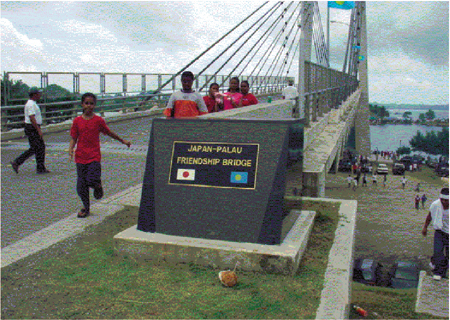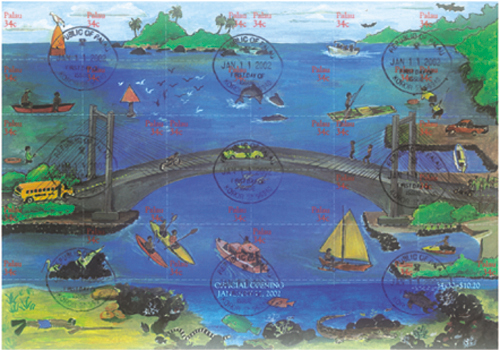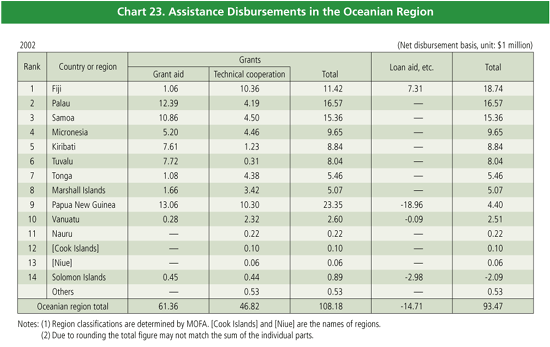
| Part III. |
ODA DISBURSEMENTS IN FISCAL YEAR 2002 |
Chapter 2
Section 2
7. Oceanian Region
Japan’s bilateral ODA to the Oceanian region in 2002 was
approximately $90 million, accounting for 1.4% of total bilateral ODA.
Japan has been providing assistance support for the Oceanian region placing
importance on the following points, as stated in the medium-term policy.
| (1) |
Japan will provide support for social and economic infrastructure
development (including health care services) which would serve as the foundation
for social and economic activities to overcome such island-nation problems
as dispersion and geographic isolation. |
| (2) |
Japan will provide support for economic structural reform. |
| (3) |
Japan will provide support for human resources development
for promoting the private sector. |
| (4) |
Japan will provide support for environmental conservation. |
| (5) |
Japan will provide support to promote wide-area cooperation
including human resources development and technology transfer through remote
education to multiple countries in the region. |
Japan has traditionally enjoyed close ties with the Oceanian
region and has gained its support for Japan’s position in international
forums such as the UN, etc. The region is vital for Japan’s deep-sea fishery
and maritime transportation, and, in recent years, hopes have risen for the
abundant sea-bed resources. Upon such circumstances, Japan has been providing
support for this region, enhancing the mutual partnership.
In the Oceanian region there are many countries that have achieved independence
relatively recently and the priority issues are to establish socially and economically
self-reliant states. The island countries also face a number of common difficulties
peculiar to island nations, such as small-scale economies, the dependence on
primary industries, geographic dispersion, the distance from international markets,
vulnerability to natural disasters, the risk of losing land territory, etc.
In providing assistance for the region, Japan considers both these common difficulties
and the individual circumstances confronting each country.
In all of the Oceanian countries, the priority issue is to develop human resources
development to support the less experienced independent states. Japan is contributing
to human resources development in these countries through technical cooperation,
such as acceptance of trainees and dispatches of experts, etc. in the administrative
sector, public services sector, etc. And in the education sector, which is the
foundation of human capacity building, the Oceanian countries are struggling
to provide all of their dispersed national territory with education services.
Japan supports to upgrade the facilities and provide equipment for the primary
schools through grassroots and human security grant assistance, and provides
education services by the members of Japan Overseas Cooperation Volunteers (JOCV).
| Column 8 |
The Japan-Palau Friendship Bridge (KB
Bridge) |
|
Surely there is no one living in Palau who does not know
this bridge. Every day many people use this elegant, easy-to-drive bridge
which is 412 meters long, ten meters wide and has a central support
41 meters high. When traveling from the international airport to the
city center, it is necessary to cross this bridge. On holidays you can
see children having fun playing around in the open space under the bridge,
while high school students clean up the place. Each year on October
1 the Government holds Independence Day Celebration in this space and
the national flag of Palau, showing a full moon in a blue sea waves
from each pillar of the long bridge. This bridge is known as the “KB
Bridge,” but because it was built with assistance from Japan it
has also been named the “Japan-Palau Friendship Bridge” and
the people of Palau have a strong attachment to it. On the occasion
of the completion of the bridge, special commemorative stamps were issued.
The bridge was built to replace the former KB Bridge, which suddenly
collapsed with an enormous crashing sound on September 26, 1996. As
a result of this terrible event, all at once water supply, electricity
and telephones lines were cut off and all the residents’ means
of living were taken away. Immediately after this collapse, the entire
country started tireless reconstruction activities which resulted in
the laying of a temporary bridge four and a half months later, but then
president Kuniwo Nakamura hoped to construct a new permanent bridge,
and decided to enlist Japan’s help. He visited Japan early the
next year and requested emergency assistance in funding and technical
cooperation. In response to that, Japan provided grant aid of more than
¥3.2 billion for the bridge reconstruction. The completion ceremony
was held in January 2002 and the elegant bridge made its debut against
the backdrop of the coral reef.
On the day the bridge was opened to traffic, many people crowded from
all over the country on to the bridge for a glance at it. It is estimated
that approximately 10% of the entire population was there. At the independence
day ceremony held under the bridge in October 2003, President Tommy
Esang Remengesau Jr., speaking in front of many Palauan and foreign
guests, expressed appreciation to Japan as follows: “I would like
to express my deep and sincere gratitude to Japan for its extremely
generous financial assistance over several years. Japan’s assistance
has contributed to the development of the majority of the trunk infrastructure
necessary for the economic development of Palau.” Today the bridge
is used as a tool in the lives of the people of Palau and as a place
for recreation.
The Japan Society of Civil Engineers rates this bridge as an outstanding
construction and has given the Society’s awards.
 |
| The reborn KB Bridge |
 |
| The KB Bridge commemorative stamp |
|
 |
Promotion of private sector industries is indispensable for the economic self-reliance
and sustainable development of the Oceanian countries which currently depend
on primary industries. Japan is providing technical cooperation such as the
training concerning the international tax administration and financial information
systems, etc. to contribute to sound economic management, and the dispatch of
experts to the tourism sector and the export promotion sector to contribute
to the promotion of the private sector through such measures as development
of the infrastructure that forms the foundation of economic and social activities,
and at the same time is contributing to the strengthening of ties between the
economy of Japan and the economies of the Oceanian countries.
Japan is providing assistance for environmental conservation and the provision
of educational services through wide-area cooperation outside the framework
of state in order to carry out efficient and effective assistance that takes
into account the geographic dispersion of the Oceanian region. With regard to
the support for environmental conservation, Japan has been contributing to solve
regional environmental problems through the dispatch of experts and training
in waste management for the “Training Education Center for the South Pacific
Regional Environmental Programme,” which was built by Japan, and through
the drawing up of waste management guidelines for the island countries. Concerning
the provision of educational services, Japan offers wide-ranging opportunities
to the people of the island nations to receive higher education through support
for distance education network facilities at the “University of the South
Pacific.”
In addition to these individual efforts, Japan has been promoting cooperation
with the “Pacific Islands Forum (PIF),” a framework for regional cooperation
composed of the leaders of the Oceanian countries. The Pacific Islands Summit,
a leaders’ meeting attended by Japan and the PIF countries, was held twice,
in 1997 and 2000, and in May 2003 the Third Japan-PIF Summit Meeting was held
in Okinawa which shares common characteristics with the island countries of
the Pacific including its climate and oceanic environment. At this summit meeting,
in addition to previous cooperation with the oceanian countries, the leaders
adopted the “Okinawa Initiative,” which takes into account the Koizumi
Initiative concerning the discussions at the WSSD in September 2002 and concrete
measures of the WSSD. The Okinawa Initiative contains a strategy and an action
plan for Japan and the Oceanian countries to together think about the development
of the region and to make joint efforts. Based on the Initiative, each country
is to take responsibility and make efforts in five priority sectors: security,
trade, health, education, and the environment.
Previous Page | Next Page


